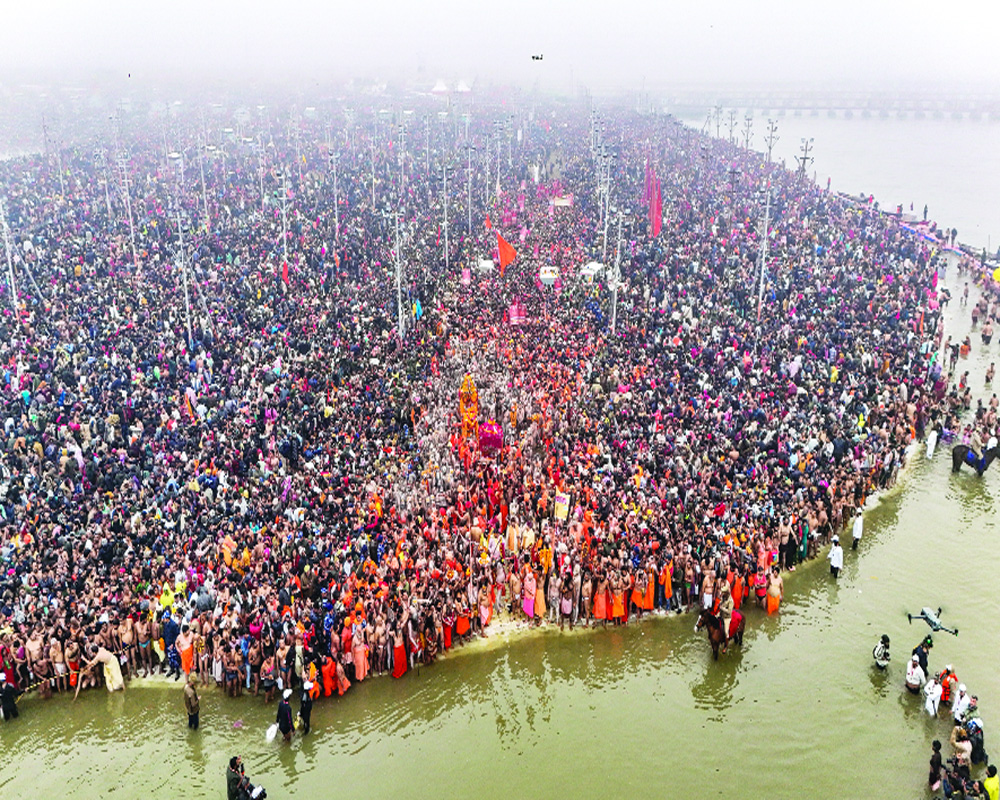The Kumbh Mela highlights the blend of tradition and modernity. It links cosmic phenomena with earthly rituals while fostering community feeling
The grand Maha Kumbh Mela, one of the most magnificent spiritual gatherings in the world, is here. The Uttar Pradesh government has meticulously prepared to host this sacred festival – happening once every 12 years – with Prime Minister Narendra Modi personally monitoring the developments. Began on January 13, 2025, the Maha Kumbh is anticipated to draw an awe-inspiring congregation of over 45 crores – a footfall of around 450 million pilgrims, saints, ascetics and tourists – devotees.
At the heart of this divine celebration, is the (coming together) ‘Sangam’ – the sacred confluence of the Ganga, Yamuna, and the mystical Saraswati rivers. Millions of devotees will come together to take a holy dip, seeking spiritual cleansing and blessings. The Maha Kumbh is a timeless testament to faith, unity, and the eternal connection between humanity and the divine, that owes its origins to mythology and history. Devotees believe that a dip during the auspicious planetary alignments cleanses sins and paves the way for Moksha (liberation). Swami Sivananda, the Yoga Guru, and a proponent of Vedanta, rightly pointed out that “The holy dip at the Kumbh Mela is not just a ritual; it is a profound surrender to the divine.” Mythologically connected, the legend of ‘Samudra Manthan’, or the Churning of the Ocean, is the cornerstone of its mythological significance. According to ancient scriptures, gods and demons churned the ocean to obtain the nectar of immortality (Amrit).
As the Gods carried away the nectar, a few drops fell at four locations – Haridwar, Prayagraj, Nashik and Ujjain – and these places became sacred. Thus began the tradition of the Kumbh Mela. Scholar Diana Eck, professor of Comparative Religion and Indian Studies at Harvard University notes that “The Kumbh Mela reflects the Indian ethos of integrating mythology with geography, turning the mundane into the sacred.”
References to Kumbha appear in Vedic texts like the Rigveda, Yajurveda, Samaveda, and Atharvaveda. It is also linked to the zodiac sign Aquarius, an astrological interpretation influenced by Greek ideas in the late 1st millennium CE. ‘Mela’ means “assembly” or “gathering” and signifies fairs or communal celebrations, as found in ancient Hindu texts.
Together, Kumbha Mela refers to a “gathering centered around water or the nectar of immortality.” Historically, the first recorded mention of the Kumbh Mela can be traced back to the writings of the Chinese traveller Hiuen Tsang in the 7th century CE. Hiuen Tsang documented several key events during Harsha’s (Harshavardhana ruled over much of northern India from 606 to 647 AD and his reign is regarded as one of relative peace and prosperity) reign. Tsang also documented the Kumbh Mela festival in Prayag which Harsha attended.
Over centuries, the festival evolved from a modest gathering of ascetics to a colossal event that attracts millions. The historical transformation of the Kumbh Mela underscores its resilience and adaptability, blending spiritual fervour with societal changes. A defining feature of the Kumbh Mela is the presence of saints, seers, and spiritual leaders who guide the masses. Various ‘Akharas’ (monastic orders) play a pivotal role in preserving and propagating Sanatan Dharma. The ascetics, often clad in saffron robes or ash, symbolise the renunciation of worldly desires. The ritual bath in the rivers further holds deep symbolic meaning. It signifies the washing away of one’s ego and sins, allowing a fresh spiritual beginning. Historian William Dalrymple observes, “The saints at the Kumbh Mela are the custodians of India’s timeless spiritual heritage.” The Kumbh Mela beautifully embodies the fusion of religion and science. Its timing, rooted in precise astronomical calculations, reflects the profound significance of Hindu cosmology. When Jupiter enters Aquarius and the Sun moves into Aries, planetary alignments create an auspicious period for spiritual connection.
This sacred festival links cosmic phenomena with earthly rituals, highlighting the deep interconnection between the universe and human spirituality. Aryabhata’s pioneering work in celestial phenomena, including planetary motion and eclipses, continues to influence the Kumbh’s timing.
The Kumbh Mela is also a melting pot of cultures, philosophies, and humanity. Participants range from reclusive ascetics to common people and even international visitors. This diversity underscores the universality of the quest for spiritual enlightenment. Sociologist Sudhir Kakar once wrote that the “Kumbh Mela is not merely a religious event but a grand celebration of human interconnectedness.” The exchange of ideas, rituals, and philosophies at the Mela fosters a unique sense of global unity.
Hosting millions of pilgrims at the Kumbh Mela demands meticulous planning, leveraging cutting-edge technologies like AI-powered crowd management systems, drone surveillance for security, and mobile health clinics to handle medical emergencies. Mobile apps and live-streaming services ensured smooth communication and global accessibility for devotees. The 2025 Kumbh will span an expanded area of 800 hectares, featuring 1.8 lakh tents and 101 smart parking facilities for five lakh vehicles daily. Despite the challenges, the event seamlessly blends tradition and modernity.
(The writer is Programme Executive, Gandhi Smriti and Darshan Samiti; views are personal)
























